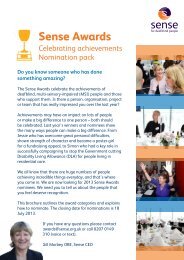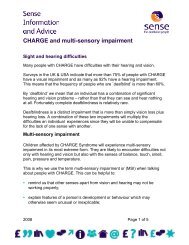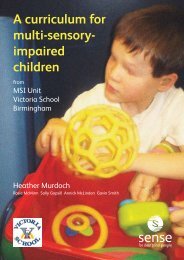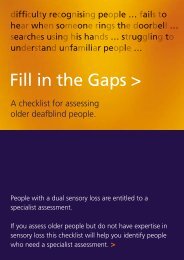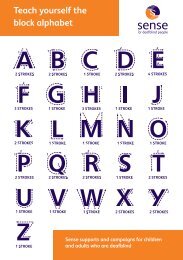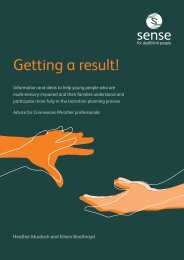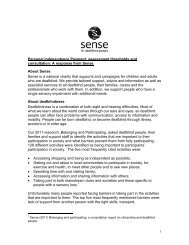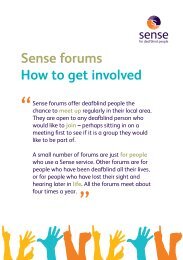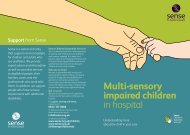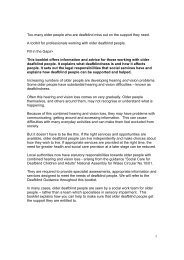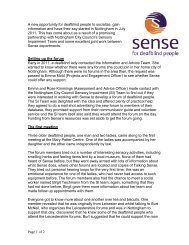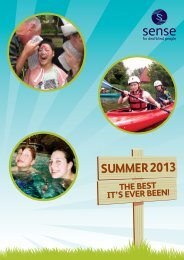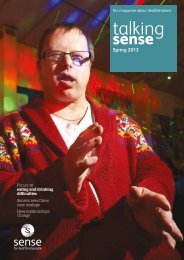Fill in the Gaps > Too many older people who are deafblind ... - Sense
Fill in the Gaps > Too many older people who are deafblind ... - Sense
Fill in the Gaps > Too many older people who are deafblind ... - Sense
Create successful ePaper yourself
Turn your PDF publications into a flip-book with our unique Google optimized e-Paper software.
2 > Legal requirementsB) EligibilityThe eligibility framework for socialc<strong>are</strong> is set out <strong>in</strong> Department of Healthguidance Prioritis<strong>in</strong>g Need <strong>in</strong> <strong>the</strong>Context of Putt<strong>in</strong>g People First. Thisguidance and <strong>the</strong> Deafbl<strong>in</strong>d Guidance<strong>are</strong> of equal status under <strong>the</strong> law.Both <strong>are</strong> statutory guidance issuedunder Section 7 of <strong>the</strong> Local AuthoritySocial Services Act 1970. Toge<strong>the</strong>r <strong>the</strong>ypromote better access, assessmentand services for deafbl<strong>in</strong>d adults .When a decision is be<strong>in</strong>g made about <strong>who</strong> is eligible for social c<strong>are</strong> services,it’s important to recognise <strong>the</strong> effect of dual sensory loss on <strong>the</strong> follow<strong>in</strong>g keyfactors <strong>in</strong> ma<strong>in</strong>ta<strong>in</strong><strong>in</strong>g <strong>in</strong>dependence:• autonomy and freedom to make choices• health and safety, <strong>in</strong>clud<strong>in</strong>g freedom from harm, abuse and neglect• personal and daily liv<strong>in</strong>g activities• <strong>in</strong>volvement <strong>in</strong> family and wider community life.The risks relat<strong>in</strong>g to each of <strong>the</strong>se factors <strong>are</strong> considered equal. So risksrelat<strong>in</strong>g to health and safety <strong>are</strong> not considered more important than risksrelat<strong>in</strong>g to <strong>in</strong>volvement. Older <strong>people</strong> with a dual sensory loss can experiencerisk <strong>in</strong> each of <strong>the</strong>se <strong>are</strong>as and <strong>the</strong>y may be at particular risk <strong>in</strong> relation toautonomy and <strong>in</strong>volvement.Case Study: Jim, 82A woman reports that her82 year old fa<strong>the</strong>r <strong>who</strong> isdeaf seemsto havebecomedepressed.Jim doesn’t seem to wantto communicate with hisfamily and isn’t eat<strong>in</strong>g <strong>the</strong>meals provided by socialservices. He has also lost<strong>in</strong>terest <strong>in</strong> his jigsaw puzzles,favourite films and regularp<strong>in</strong>ts at <strong>the</strong> pub nearby. Heseems to be withdraw<strong>in</strong>g <strong>in</strong>tohis own world. What will <strong>the</strong>assessment uncover?Because Jim is still manag<strong>in</strong>gto carry out his own personalc<strong>are</strong> and is supported with dailyliv<strong>in</strong>g tasks by his daughter<strong>who</strong> visits twice a week, ageneric overview assessmentconcludes that <strong>the</strong> risks to his<strong>in</strong>dependence <strong>are</strong> moderate(and outside <strong>the</strong> band<strong>in</strong>gthat would make him eligiblefor services <strong>in</strong> <strong>many</strong> localauthorities).If a deafbl<strong>in</strong>d person is screened out at this <strong>in</strong>itial stage, this will notmeet <strong>the</strong> requirements of <strong>the</strong> Deafbl<strong>in</strong>d Guidance. This states that allassessments of deafbl<strong>in</strong>d <strong>people</strong> (<strong>in</strong>clud<strong>in</strong>g eligibility assessments) shouldbe carried out by someone specifically tra<strong>in</strong>ed to do so. This is an importantmessage of <strong>the</strong> Guidance.10



